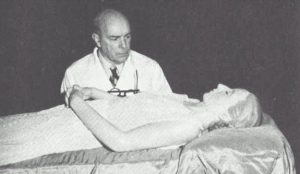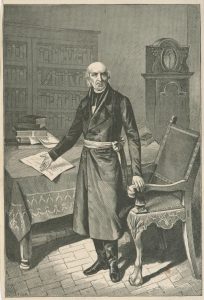865 AD, Northumbria, England. It is a cold and dreary afternoon in the Northumbrian woods. The dark clouds gathered in the sky as Ragnar Lothbrok, King of the Danes, sits captured above a pit of vipers, awaiting his fate. King Aella, the Northumbrian king, stands before the defeated Dane triumphantly. Valhalla was close at hand. Ragnar’s thoughts shifted to his sons, and he declared a prophecy to Aella: that the sons of Ragnar will one day arrive on English shores to wreak vengeance upon the Northumbrian kingdom and all of England. Aella chuckled, brushing off the pagan king’s words as silly Viking magic; and with that, Ragnar was promptly thrown into the pit. Ragnar stared at his foe from below as the vipers bit him from all sides, the venom coursing through his veins. The king of the Danes was dead, and the pagan threat to Northumbria finally defeated.1 Little did King Aella know that he had ignited the vengeance of a Viking warrior so ruthless and so horrible, that the mere mentioning of his name would incite terror amongst Saxons, Norse, and all the inhabitants of the British island alike for ages to come: his name was Ivar The Boneless.
Ivar Ragnarsson, better known by his moniker “Ivar The Boneless” was the eldest son of the legendary Danish king Ragnar Lothbrok and his wife, Aslaug. He was regarded by the Nordic Sagas as the cleverest and most cunning of Ragnar’s sons. It is not understood how he achieved his strange nickname; and later Viking media and entertainment has provided multitude of interpretations on Ivar’s supposed metaphorical lack of bones. Ivar may have genetically contracted a type of degenerative bone disease or he may have been handicapped; however, his prowess as a warrior seems to refute such claims.2 The Nordic saga, The Tale of Ragnar’s Sons, suggests that Ivar was highly likely suffering from a rare case of impotency, describing him as lacking any “lust or love”; hence the sagas grant him the nickname “boneless.”3

Ivar’s story began in Scandinavia, following the events of his father’s death. The tragic news of King Ragnar’s demise eventually reached the Viking lands, where Ivar and his brothers patiently waited for their father’s return from raiding. In all, the brothers numbered five: Bjorn Ironside, Sigurd Snake-in-the-eye, Halfdan, Ubbe the Dane, and Ivar. Ivar and his brothers swore an oath of revenge, promising not to rest until King Aella was dead. Together, the sons of Ragnar summoned all of the loyal Danes and Norsemen of Scandinavia, assembling the largest army the Viking world had ever seen: The Great Heathen Army. 4
It is said in the Norse Sagas that Ivar was actually not as eager as his brothers to wage war with King Aella. According to the Tale Of Ragnar’s Sons, Ivar did not join his brothers in the initial battle against Aella, due to the fact he and his men refused to fight. The sagas explain that Ivar actually approached Aella and asked to be recompensed for his father’s death. Aella agreed to give Ivar as much land as he could cover with a large bullhide, in exchange for Ivar to refrain from raiding his lands. Ivar stretched out the hide and cut it into fine string, making a wide enough foundation to build a city. From the bull hide, Ivar and his men built a large Viking garrison; and Ivar sent word back to his brothers that it was time to strike.5 This is highly likely a metaphor for Ivar’s cleverness, and not an actual event that occurred. Furthermore, the saga proclaims that the garrison was named York; but the Northumbrian city of York predated the arrival of Ivar and the Great Army and was only occupied by the Vikings after Aella’s death.

During the winter of 865, the Great Heathen Army, under Ivar’s command, arrived on the shores of the Anglo-Saxon kingdom of East Anglia. While there, the army set up camp and waited for the Spring season before proceeding into Northumbria. Once the snow melted, Ivar led the army towards York (Northumbria’s capital city) to face Aella and his co-king Osberht, capturing the city in a decisive battle in 867 AD. The battle was brutal and bloody, as Vikings and Saxons went toe-to-toe, crushing skulls and clashing swords. Cries of “Odin!” and “Tyr!” the ancient Norse gods of death and warfare respectively, rang loudly. Ravens, waiting eagerly to scavenge of the carnage, flew through the air. After the dust of battle had settled, the Saxons were finally defeated. Osberht was killed, and thus King Aella surrendered, now at the mercy of the sons of Ragnar.6
Ivar was eager to gain his revenge. Indeed, Aella’s fate was to be executed, but Ivar desired a spectacle. Promptly following the battle, Aella was brutally tortured by rite of the Blood Eagle: an extremely painful method of execution rumored to be practiced by the ancient Norse. The ritual is mentioned only twice in the Nordic sagas, and historians have never proved such a ritual to be true, or that Ivar himself practiced it.7 Nonetheless, this merciless method of execution involved creating an incision on the victim’s back to reveal the ribs, which were then broken apart with an axe and pulled back. The victim’s lungs would then be placed upon their shoulders, so that they would appear to look like the folded wings of an eagle. And it was so; King Aella was dead, and the kingdom of Northumbria had fallen to Ivar and his Viking horde.8
Following Aella’s death, the sons of Ragnar went their separate ways. Halfdan remained in Northumbria to oversee affairs there, Sigurd returned to Denmark to rule as king as his father had, and Bjorn, now a jarl of Sweden, retired back to his realm.9 Only Ubbe and Ivar remained with the army; and although Ivar’s brothers were satisfied with their victory, Ivar’s eyes looked towards further conquest. It wasn’t enough to see Aella executed; Ivar wanted all of England to know him and to fear him. Ivar wanted to carve a bloody hole into the heart of England; and he proceeded to lead the Great Army towards the southeast once again. The following year, Ivar and his army returned to East Anglia, which was ruled by King Edmund. The Great Army made quick work of East Anglia’s Saxons, conquering the kingdom swiftly. Ivar executed Edmund in a particularly sadistic manner; upon the surrender of East Anglia, Ivar ordered King Edmund to be tied to a post and filled with arrows, as a consequence for refusing to renounce his Christian faith. Much to Ivar’s joy, King Edmund died a slow and painful death, as Ivar’s men fired arrows into his body as if he were a target. To celebrate their victory, Ivar and the Great Army went on a rampage across East Anglia, pillaging and burning the monasteries that dotted the countryside.10 By 869 AD, the kingdom of East Anglia had fallen to the Vikings.

One by one, king by king, kingdoms fell before Ivar and his army, for no Saxon stood a chance against Ivar’s rage; Northumbria was now ruled by a puppet king, East Anglia was in flames, and Mercia was becoming increasingly occupied by the Danes. By the time the Great Army split in 873 AD, all of the English kingdoms had fallen to heel, with the exception of Wessex in the far south. Shortly before the splitting of the Great Army, Ivar passed the torch of leadership to the Jarl Guthrum, who would soon march into Wessex with the army’s remnants in a daring attempt to unseat King Alfred.11 Ivar’s ambitions took him elsewhere, as he renewed his contract with the Irish Viking Olaf the White. Together, they maintained a presence in Ireland and launched repeated raids into Scotland.12 Finally, after almost eight years, Ivar’s reign of terror in England was over. By the time Ivar retired his leadership of the Great Army, he had killed not one, not two, but an astounding total of three English kings. Vikings were known for their guerrilla warfare tactics and small, maneuverable raiding parties; the ability to kill an English monarch, let alone three English monarchs, was unheard of in the Viking world prior to Ivar’s time. It is a testament to the fact that Ivar’s ruthlessness and ability to be unspeakably brutal in warfare is what granted him so much prestige in the ranks of the Great Army.
Unlike many of his Viking predecessors, his father included, Ivar’s ambitions for conquest were not fueled from lack of basic resources or adventure; Ivar waged war and death simply because he found pleasure in it. Ivar left behind a shattered and fragmented England, ravaged by his years of Viking terror and warfare. His story is one shrouded in both mystery and legend; a classic tale of a son’s vengeance and the triumph (or rather excessive bloodshed, in Ivar’s case) that follows. The exact date, location, and circumstances surrounding Ivar’s death are unknown, but the Tale of Ragnar’s Sons attests that Ivar was entombed in a burial mound somewhere in England. The unearthing of a mass Viking burial in Repton, England, revealed the remains of a Viking chieftain surrounded by hundreds of his fellow fallen warriors. This grave is believed to be the tomb of the great Ivar the Boneless, but the exact final resting place of the infamous Viking still remains a mystery.13 By the time of his death, Ivar was dubbed as the “King of all Norsemen in Ireland and Britain.”14
- History Time, “The Real Ragnar Lothbrok // Vikings Documentary”, 2018, https://www.youtube.com/watch?v=4bjo_WYgRd0. ↵
- Robert Lewis, “Ivar the Boneless | Biography, Battles, & Facts | Britannica,” accessed February 3, 2021, https://www.britannica.com/biography/Ivar-the-Boneless. ↵
- Peter Tunstall, “Fornaldarsögur Norðurlanda,” The Complete Fornaldarsogur Nodurlanda, accessed February 26, 2021, http://www.germanicmythology.com/FORNALDARSAGAS/ThattrRagnarsSonar.html. ↵
- Josh Butler, “The Great Heathen Army,” Historic UK, accessed February 28, 2021, https://www.historic-uk.com/HistoryUK/HistoryofEngland/Great-Heathen-Army/. ↵
- Peter Tunstall, “Fornaldarsögur Norðurlanda,” The Complete Fornaldarsogur Nodurlanda, accessed February 26, 2021, http://www.germanicmythology.com/FORNALDARSAGAS/ThattrRagnarsSonar.html. ↵
- Josh Butler, “The Great Heathen Army,” Historic UK, accessed February 28, 2021, https://www.historic-uk.com/HistoryUK/HistoryofEngland/Great-Heathen-Army/. ↵
- Mike Dash, “The Vengeance of Ivarr the Boneless,” Smithsonian Magazine (blog), March 18, 2013, https://www.smithsonianmag.com/history/the-vengeance-of-ivarr-the-boneless-4002654/. ↵
- Josh Butler, “The Great Heathen Army,” Historic UK, accessed February 28, 2021, https://www.historic-uk.com/HistoryUK/HistoryofEngland/Great-Heathen-Army/. ↵
- Peter Tunstall, “Fornaldarsögur Norðurlanda,” The Complete Fornaldarsogur Nodurlanda, accessed February 26, 2021, http://www.germanicmythology.com/FORNALDARSAGAS/ThattrRagnarsSonar.html. ↵
- Josh Butler, “The Great Heathen Army,” Historic UK, accessed February 28, 2021, https://www.historic-uk.com/HistoryUK/HistoryofEngland/Great-Heathen-Army/. ↵
- Joshua Collins, “Alfred The Great And The Battle of Edington,” STMU History Media (blog), November 7, 2020, https://stmuhistorymedia.org/alfred-the-great-and-the-battle-of-edington/. ↵
- Robert Lewis, “Ivar the Boneless | Biography, Battles, & Facts | Britannica,” accessed February 3, 2021, https://www.britannica.com/biography/Ivar-the-Boneless. ↵
- Josh Butler, “The Great Heathen Army,” Historic UK, accessed February 28, 2021, https://www.historic-uk.com/HistoryUK/HistoryofEngland/Great-Heathen-Army/. ↵
- Robert Lewis, “Ivar the Boneless | Biography, Battles, & Facts | Britannica,” accessed February 3, 2021, https://www.britannica.com/biography/Ivar-the-Boneless. ↵




20 comments
Andrew Ponce
The author does a great job at not only writing the article, but first selecting a topic. Not many people know about Ivar the Boneless, as his story gets overshadowed by other stories during his time. Despite this, the author was able to find a lesser known story and show his audience why it can be less popular, but still extremely interesting. It is always great to hear fun stories like this.
Carlos Hinojosa
It’s nice hear lesser known stories about certain regions because they usually get overshadowed by better civilizations or people at the same time. I never have heard of Ivar the Boneless and honestly he sounded pretty cool. Brutal yes but cool nonetheless. This article did a good job at describing who Ivar was and what he did. A great read and a even better article.
Camryn Blackmon
I first wanted to acknowledge how the featured image you chose for your article really grabs people’s attention. When scrolling through articles, I saw the image and felt like I needed an explanation behind the image. The article was well-written and written with great detail.
Grace Frey
This was a very interesting article about a kind of crazy time in history. The level and type of violence that occurred in this era is crazy. I had never known about Ivan’s alleged disability, only his tendency for violence. It is even more crazy that sometimes his tendency for violence didn’t even have a purpose and was rather just because he wanted to kill and destroy. Great job on writing such an interesting article over a period of history that not too many people are interested in.
Robert Colwell
The Vikings were an absolutely ruthless people, and Ivar the Boneless proved that alone. This article was extremely informative and fun to read and instantly made me want to go watch documentaries about Vikings. Ivar the Boneless is a very interesting character and this article was very informative about his life.
Faith Chapman
Born ‘Ironside,’ Sigurd ‘Snake-in-the-eye,’ Ubbe ‘the Dane’—I do not know if all these names of Ivar’s brothers were all monikers of theirs such as his is ‘the Boneless,’ but if they are indeed nicknames of his brothers, I wonder how each of them gained those titles. Curiosity aside, this was a very interesting article to read; Ivar seemed like a Greek hero in this story.
Roberto Macias-Marin
Hello,
Medieval history has always been one of fascinating figures in history that just amazes you the strength and tenacity they had to survive in such a harsh environment. The history of the Viking raids was a brief but rather impacting time for west Europe since this greatly saw a rough clash among cultures that started with Ragnar and continued with his sons. Ivar’s story is a rather fascinating one, especially when you consider most children born with a disability to be considered useless in the Viking culture and left for dead. Great article!
Allison Grijalva
Hi Elliot! Your creative title and first image really caught my attention! The photo you utilized to show the Viking territories was extremely helpful for a visual reference, as I did not have much prior knowledge on this subject. Ivar seems like a person who would not have existed because of his extreme behavior and personality as described in this article. He seems like a television character created for entertainment! This article was great to read and I felt like I was reading an action novel!
Yousef Alghamdi
Hi Elliot,
Very well-written paper. You have done a great job explaining such an interesting historical figure, Ivar. Ivar character is well known due to the Viking show that he was presented in. However, I like how you mentioned Ivar’s spread with his army as Ivar’s Rage, it explains a lot of the personality behind him. It is fascinating to read how ruthless he was.
Edward Cerna
This article is by far one of the most interesting articles I have read. I’ve always been interested in topics such as this so It definitely kept engaged throughout the entire article. It is fascinating just how violent and ruthless times were in the past especially with the practice of the blood eagle that was mentioned in the article.